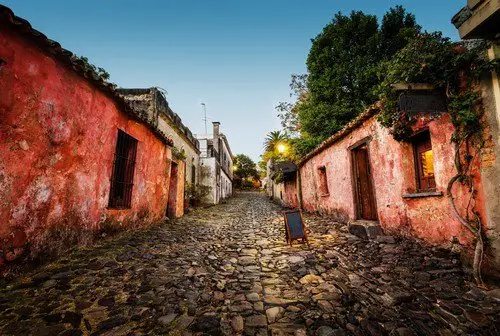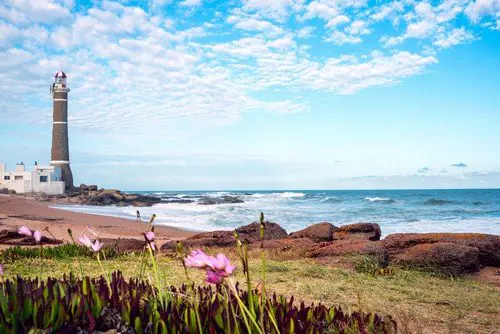The Budget Uruguay Travel Guide includes 18 Important Travel Planning Tips that will allow you to see and do more on your budget. Learn how you can benefit.
Welcome to the Uruguay Travel Guide! Of all the Latin American countries Uruguay is certainly the easiest to enjoy on a more practical level. It is extremely safe and stable compared to some of its regional neighbors, yet also has plenty to attract the more worldly and open-minded visitor. This is a country where you can casually and confidently explore at your leisure – no parts are ‘out of bounds’ to visitors – and enjoy some of the finer things that the continent has to offer.
Uruguay certainly offers a more tranquil experience than many people expect, and for those new to far-flung travel and those looking for a slightly more relaxed pace after a spell exploring other places in the region, it is an ideal opportunity to explore the more chilled-out side of South America.
Uruguay Travel Guide – What Are the Best Places to Visit in Uruguay?
Montevideo is one of those cities that is easy to fall in love with. Boasting plenty of colonial architecture offset with some surprisingly gentle on the eye more modern constructions, it is an easy city to walk around and explore at leisure. Allow for plenty of time to relax around the cosmopolitan Plaza Independencia and iconic Palacio Salvo – we recommend one of the local walking tours that’ll provide an interesting insight a little beyond what you’ll find in most local guidebooks.
Make sure to check out the Jardín Botánico de Montevideo (botanical gardens), Mercado del Puerto (upmarket shopping where haggling is acceptable!), and if your Spanish is up to the task a show at the legendary Teatro Solís. Montevideo is a great city for culture vultures and those who simply like to roam about an interesting and rather exotic place with next to no hassle. Oh – did we mention the enormous and gorgeous beaches yet? It really does have something for everyone!
Outside of Montevideo what else is there to see in Uruguay? The Uruguay Travel Guide would highly recommend all visitors make the effort to see the Colonia del Sacramento – a truly beautiful UNESCO sponsored colonial-era site that is both utterly gorgeous and handily located right on the Río de la Plata. If you find yourself in the mood for something with a slightly higher party-buzz then be sure to head over to Punta del Este – drinks are cheap and the atmosphere better than you’d expect.
This area is the culinary part of Uruguay and you’ll find most of the best restaurants here. Prices are affordable – certainly compared to most other countries – and the quality is second to none especially if you enjoy some freshly caught seafood.
You’ll have plenty of options when it comes to exploring the rest of the country too. Outside of the most visited spots, you’ll have large parts of this beautiful country entirely to yourself making it perfect for travelers with a real sense of wanderlust. We suggest that anyone partial to a drop of wine or two takes the time to see Carmelo town – the heart of the national vineyards.
The tours are worth taking even if you aren’t all that interested in the wine as the ‘Uruguayan Tuscany’ makes for some beautifully scenic strolls. If you’re after a more demanding hike (and that term is really relative in this country) then a couple of hours north of Montevideo will take you to the Minas hiking region. Packed with caves (watch out for the bats!), offset with atmospheric forests, and adorned with gently rolling hills and the occasional lake – it’s ideal for unrushed walking and biking.
If you want to head somewhere more remote (and with a slightly less European vibe) then make sure to aim east towards the Rocha villages. This is proper Latin American ‘outback’ where you’ll find cowboy culture – and tie-dyed hippies – happily coexisting in tranquil little oasis communities. It is a superb spot for both cultural and scenic photography and we highly recommend you take your time here to check out the amazing local wild and birdlife too. You’ll spot plenty of beautiful creatures throughout your time in Uruguay – and they’re refreshingly casual about being the center of attention!
No matter how you intend to spend your time in Uruguay you’ll rapidly fall in love with this friendly, laid back and ever so worldly country. The Uruguay Travel Guide highly recommends that visitors take this country at a leisurely pace and enjoy the fact that it’s so easy compared to more challenging neighbors! Uruguay is pretty much as cool as a country can get.
Uruguay Travel Guide – What Are the Best Things to Do in Uruguay?
Uruguay is a perfect example of a country where visitors can really make their own fun. It is so easy – and safe – to explore to your heart’s content that you don’t really need much of a plan in mind before arriving. We at the Uruguay Travel Guide would highly suggest that visitors try and make sure they see the distinct parts of this country over the course of their tour. A few days in Montevideo is seriously recommended – it’s an amazingly cool city to just roam about and stumble across those rarer museums, galleries, markets, and studios. The surrounding scenery is beautiful too – so take the time to really soak up the ‘big city’ Uruguay experience.
You can quite easily navigate your own way around this country but there is something to still be said for taking occasional tours. Some of the most breathtaking scenery is difficult to access using typical public transport – so a set of wheels is a handy factor, especially when it is being driven by a local expert. Shop around and see if specific tours and experiences are going to match your requirements. Everything from surf lessons through to organized bird watching tours, scuba diving, hiking expeditions, vineyard tours, and much more are readily available – and often at bargain prices.
Shopping is a big deal in Uruguay and you’d be crazy – or very short on your baggage allowance – to not be tempted to pick up some souvenirs from one or two of the country’s most famous marketplaces. Haggling is fair-game most of the time and there are not many restrictions on what can be legally exported besides very valuable antiquities and relics (that’ll be well beyond most people’s budgets anyway!). Take in the famous markets at leisure and our advice would be to look for products that are made within the country itself – we’ll discuss this a little further during our responsible travel section.
Uruguayan beaches may not be as famous as those in Brazil but you’ll enjoy the fact that they are far less crowded and usually enjoy a pretty perfect climate! As with much of the rest of the country, enjoy the laid back and easy going eclectic style of these regions. You’ll find no shortage of things to do – especially if you enjoy beach sports and perhaps a little bit of surfing if the swell is up.
Plenty of visitors to Uruguay notice that culturally and aesthetically the country is quite similar to Argentina (many travel guides bundle the two together) and there is certainly a degree of truth to this. But do not assume that Uruguay ought to just be considered the little brother – it has plenty to offer visitors in its own style, and those who enjoy a more hassle-free and low-stress experience will appreciate that key difference.
Uruguay Travel Guide – When is The Best Time to Visit Uruguay?
Uruguay enjoys a very stable, predictable, and mild/warm climate that makes it an accessible country for long stretches of the year. Most people opt to visit between October and March (Uruguayan spring/summer) when you’ll enjoy mild yet perpetually sunny weather. This climate makes it perfect for hiking, exploring, and chilling out on the beach. If you are aiming to spend plenty of time on the beaches perhaps look towards October-December to avoid the thousands of Argentinians who mostly visit between January and March!
Our advice at the Uruguay Travel Guide would be to try and time your visit to coincide with the February festival season in Montevideo. The climate will be perfect and the rest of the country will still offer plenty of that laid back refinement!
| GOVERNMENT LINKS |
| General Information VISAS Tourism |
Uruguay Travel Guide – Do I Need A Tourist Visa in Uruguay?
Unsurprisingly this is a really easy country to enter and exit. Most visitors – including those from the USA, Canada, UK/EU, Australia, NZ, and plenty of others can visit without a visa. Your passport (which must be valid for a further six months) will be stamped with a 90-day tourist visa that should be plenty of time to see the best of the country. Extensions can be more awkward to arrange and you’ll need to provide a good reason and prove you have the means of supporting yourself. Note that special visas are required for anyone working or studying in the country and that these can be approved for years of unlimited access.

Uruguay Travel Guide – What Currency Is Used in Uruguay?
The Uruguayan peso (UR$) currently exchanges for around UR$38 = 1USD.
To avoid confusion we’ll use USD when quoting approximate prices for the Uruguay Travel Guide.
You’ll find that many prices in tourist areas in Uruguay tend to be quoted in US Dollars – especially accommodation and tour costs. US currency is widely accepted – you can sometimes even have it issued at ATMs – but only really for big-ticket expenses. You’ll still need local money for the daily essentials and the good news is that ATM rates are plentiful, rates are very reasonable and the vast majority of machines accept internationally issued cards. There are money changing desks dotted around popular attractions but chances are you’ll rarely need them. A good number of more isolated hostels/hotels offer money changing facilities at uncompetitive rates.
We’ve already mentioned that haggling is part of the market experience – but be aware that elsewhere in the country there is rarely much room for any negotiation. It is almost always worth trying your luck if you are looking to arrange a stay somewhere longer than usual or are looking to book a tour as a large group – but beyond that accept the fact that quoted prices tend to be the prices. Overall, handling your finances in Uruguay is really simple, and made even easier thanks to that very low crime rate.
Uruguay Travel Guide – Do I Tip In Uruguay?
Tipping is expected in Uruguay although not quite as forcefully as elsewhere in Latin America. Allow for 10% extra on restaurant meals (provided you are satisfied with the service and quality) and leave the change on notes for cab rides and room attendants. Something you may notice in Uruguay is that many tours do not expect additional tips for guides/porters. Those who do will almost always quote this fact within their literature. Tipping a little is still a good idea provided you’re happy with the tour – but it is ultimately up to you.

Uruguay Travel Guide – What Kind Of Budget Do I Need In Uruguay?
Safe, stable, dependable – words not widely applied to many Latin American countries but most certainly applicable to dear old Uruguay! The Uruguayan economy is considerably steadier than most and prices do not tend to change with the same kind of alarm as you’d find in Argentina. That being said, the prices between the two are broadly quite similar, meaning that you can certainly explore Uruguay on a budget but don’t expect things to be quite as cheap as you might have expected.
We’ve very roughly costed-out three approximate daily budgets that should serve as a good idea of how far you can expect your money to take you in Uruguay. There is leeway for making it cheaper – or insanely expensive – if you wish, but the vast majority of visitors will straddle parts of these three options (remember prices are in USD):
Budget ($50/day)
Truth be told – if you are happy staying in hostels/bunkhouses and eat on-the-go most of the time, you can easily spend little more than $30/day in Uruguay and still enjoy a fantastic time. Basic accommodation tends to be clean and often very well located. Dorm rooms go from between $15-35/night depending on where you are and what time of year you are visiting. Sometimes basic hotels/motels are available at similar prices and outside of the major cities and tourist spots chances are these will provide the handiest budget travel options.
Transport is a bargain in Uruguay with bus rides basically costing somewhere around $6/7 per 100km traveled. Single urban bus tickets are rarely more than a dollar. Food is also very reasonable and you’ll be able to get by on about $20 every day assuming you aren’t looking towards fine dining – or are saving that for the best eating spots in the country. So while Uruguay isn’t quite as cheap as many people assume or hope for, you can still spend plenty of time in this beautiful country without spending huge sums of cash.
Mid-Level ($100/day)
Again – we’ve pushed the boundary further north than it needs to be simply because this budget allows the ‘general’ visitor to do pretty much whatever they like during their stay in Uruguay. You’ll find good double hotel rooms for about $60-70 (remember that price is shared) but may find it more fun to stay in private rooms at hostels for a more fun atmosphere and chance to share travel trips with others. Look to take day-long and perhaps even multiple day tours within this budget.
Pony trekking that includes basically all costs and provides accommodation tends to start at around $100/day. City walking tours that last for several hours rarely cost more than $10 and are usually donations-only.
Car hire is a serious option in Uruguay – and once more that is something rarely said for the rest of Latin America. Roads are decent enough, other drivers appear to have mostly passed their driving exam, and conditions are rarely anywhere close to challenging. A standard vehicle including insurance will cost about $30-40/day not including gas. For groups that can really help to open up the more distant parts of the country and barely any more expensive than what you’d pay on slower public transport.
While it is not the most environmentally sound option, car hire is a realistic choice in Uruguay. Note that prices are substantially cheaper when booked in advance before you enter the country thanks to being able to fast track registration and insurance details.
High-End ($150+)
Something you’ll struggle not to notice in Uruguay is that high-end travel costs tend to quite rapidly raise towards the kind of prices you’d expect to pay in the USA and/or Europe. High-quality five-star rooms cost from $150 and upwards, fine dining with good wines often hits the $100/head figure and more, and first-class transport is often two or three times higher than the norm. If money is no object you could arrange car hire once you are in the country – just be prepared for prices to be around 40% higher than they would be booked in advance.
Our advice would be to try and enjoy some of the finer things in life during your time in the country – but also ask whether or not it is really worth spending big money on more luxurious accommodation. By our estimation accommodation standards are good enough at lower ends of the market, and instead save that extra money on more specialist/professional tour options or even just the most lavish meal of your lifetime!
If Uruguay isn’t exactly bargain basement when it comes to prices one thing that we can say with certain confidence is that you’ll usually enjoy excellent value. As with Argentina accommodation tends to be pretty decent standard, food can be seriously fantastic often in the most unexpected ways, and travel costs do offer staggeringly good value especially over longer distances. You don’t need to look far beyond the most traveled tourist routes to find sensational value in Uruguay – and that’s all part of the fun!

Uruguay Travel Guide – What Languages Are Spoken in Uruguay?
99% of people in Uruguay speak Spanish although you’ll still find small parts of the country where Portuguese is effectively a second language – used on a daily basis by about 15% of people. English is spoken a little more commonly compared to most local countries especially in cities and commercial districts. As with pretty much anywhere else on the planet if you need instructions in English you’ll be better of chancing your luck with younger people!
We at the Uruguay Travel Guide would not expect anyone to encounter any major issues regarding language or being understood in the country. It is easy enough to navigate with or without a language barrier – and you’ll find someone who speaks at least basic English almost everywhere.
Uruguay Travel Guide – What Religions Are Practiced in Uruguay?
Religion is still a cultural power within Uruguay although you’ll perhaps notice it is a little more benign compared to other local nations. Christianity – mostly Roman Catholicism – is followed and practiced by close to 60% of the population, with the rest being made up of people with ‘no faith’ and very small pockets of other religions. Although you should still behave respectfully and dress a little smarter when visiting religious sites and areas, you’ll not experience any issues regarding religion within the country itself.
Uruguay Travel Guide – Practical Tips From The Uruguay Travel Guide
We hope you have enjoyed reading the Uruguay Travel Guide so far. Compared to the rest of Latin America there is really something quite exceptional about the stability and comparative wealth enjoyed within this country. Although Uruguay isn’t exactly rich in global terms, it does have a substantial middle class that generates comfortable levels of personal wealth.
You’ll notice very few examples of the stark and often in-your-face poverty experienced in many other countries. Even the large cities barely have anything close to the slums/favelas you’ll find not too far away. As such, Uruguay is quietly proud of the fact that it is somehow more prosperous, stable, relaxed, and yes – liberal/conservative – than their neighbors.
At this stage of our travel guide, we’ll now take a look at the practicalities of enjoying this country to the full. Truth be told, Uruguay is perhaps best enjoyed either as a unique destination or as a refreshing change of pace to a wider regional tour including other countries. After a while trekking through Brazil, Chile, Paraguay, and to a lesser extent Argentina you’ll love the fact that buses run close to their timetabled times, rooms are uniformly clean, tap water is drinkable, people are laid back, and the rather eclectic atmosphere that tends to pervade aspects of Uruguayan life.
Uruguay Travel Guide – What About Health and Safety in Uruguay, Is It Safe?
Uruguay is without question the overall safest country to visit in Latin America. Crime does exist in Montevideo and isolated parts of other cities but is rarely violent and unlikely to be especially geared towards visitors. Provided that you take suitable care, avoid drugs and public intoxication, stick to well lit and populated areas, chances are you’ll not encounter any issues whatsoever.
Even pickpocketing is very rare although you may want to consider a money belt anyway just in case. While Uruguay has famously relaxed drug laws remember that these do not necessarily apply to visitors and that taking these publicly is still illegal. Tourists are deported every year because they fail to appreciate this fact.
Thanks to that near-perfect climate Uruguay enjoys little in the way of especially risky infectious diseases. You’ll likely not require any special vaccinations before you travel. The country operates a good quality public health system but visitors should still take out travel insurance to have both access to the best facilities and for help with potential repatriation costs. Pharmacies are well stocked and often offer many US/European brands but do not expect these as a matter of course.
Should you lose your prescription medication chances are you’ll need to visit a doctor (almost all speak English) for a fresh script. Upload essential medical information securely to the Cloud for easy retrieval to help speed up this process.
You’ll unlikely experience any specific environmental risks anywhere in Uruguay although you should still take care around coastal parts to watch out for rip tides, and remember that some trekking trails aren’t perfectly well signposted. Make provisions for these basics and you’ll enjoy a perfect visit to this welcoming and refreshingly safe country!
Uruguay Travel Guide – What is the Best Transportation in Uruguay?
Most visitors to Uruguay will be well served by the country’s high-quality bus network which provides good value across an extensive network of national, regional, and private operators. It is sensible to buy tickets a day or two ahead of departure not only to reserve a place but to also make sure you are taking the best/most suitable option for your needs.
The classification system (what constitutes ‘luxury’, ‘executive’ etc) takes some getting used to the first couple of times. Once you are used to it you’ll find that the bus system can take you to all the key sites and close enough to most of the rest. Remember that services tend to be limited on Sundays and almost nonexistent during national holidays or festivals.
The Uruguayan rail network is perfectly fine for taking the scenic – and often quickest – route between the major cities but you’ll still need to use buses to get anywhere beyond the urban centers. Some of the routes do offer utterly gorgeous views but it is best to consider the railways as an experience in their own right rather than a reliable way of seeing the best of the country. Car hire – as discussed previously – is a really viable option in Uruguay and can be both great value and a really handy way of heading wherever you please. Internal flights do exist but should really only appeal to business visitors or those in a hurry.
One of the most significant aspects of visiting Uruguay is actually deciding how you wish to arrive in the country. A high proportion of international flights actually only fly to Argentina – meaning you’ll need a local flight to actually get to Montevideo. there are exceptions to the rule but look to book well in advance if you want truly direct flights. Approaching by road or rail is actually a good way of arriving in Uruguay especially if you are coming from the north or west. The shift in the atmosphere is noticeable the moment you cross the border!
The Uruguay Travel Guide highly recommends visitors try and make use of bikes at some stage of their adventure. Large parts of Uruguay make for magnificent cycling and by no means do you need to be exceptionally fit to cover plenty of miles every day. Consider this especially if you intend on exploring the coast – some of the views are sensational.

Uruguay Travel Guide – What Are the Best Accommodations in Uruguay?
You’ll rarely encounter any problems finding somewhere to stay in Uruguay – although as with pretty much everywhere it is advisable to book your spots at popular hostels and lodges well in advance during the busiest months. Rates tend to not vary a huge amount in regards to quality but are geared more specifically towards the location and the time of the year. If you visit the coastal areas outside of the busiest season you’ll often find 50% discounts on rooms in the remaining hotels that stay open.
As Uruguay is a pretty advanced Latin American country you’ll find plenty of online resources and choices for arranging private accommodation. We highly suggest looking in this direction – not because you’ll necessarily save much money – but because you’ll likely discover more interesting and unique places to stay. Montevideo is a fantastic city that can become even better if you are lucky enough to stay in a local’s spare room. Take a look at the popular online booking sites and see what takes your fancy.
Our last but by no means least word of advice when it comes to finding somewhere to stay is to remember that early booking really does matter more than usual in this country. Where discounts exist they are almost always proportionate to make your arrangements well in advance – and not really in the sense of getting a 5-10% discount for staying longer or in greater numbers of people. It is pretty similar to the USA and Europe in this regard.
Uruguay Travel Guide – How Can I Practice Responsible Tourism In Uruguay?
One of the best ways of being a responsible visitor to Uruguay is to ignore the fact that it’s comparatively small and take the opportunity to really explore this wildly contrasting, eclectic, and thoroughly endearing country to the full. Montevideo rightly claims most of the plaudits – for us, it’s perhaps the coolest city in Latin America – but do your best to explore wider and you’ll discover some truly spectacular sights. It is the kind of country where you’ll be bound to think at some stage of your stay “I could live here”.
While Uruguay is not without its environmental worries and at risk of some dangerous development it is better at managing these pressures than most neighboring countries. Our advice would be to stick to the glitzy and glamorous resorts if you’re in the mood for that kind of thing and keep the idyllic, tranquil, and largely untouched small fishing villages as unique and unspoiled as possible. Keep your tours to specialist agencies wherever possible – many local conservation trusts (often associated with universities) run tours as part of their fundraising campaigns. Support these where you can.
Overall you’ll not have any problems being a responsible visitor to Uruguay providing you follow the basics. Keep an eye on your fires if you head out camping, clean up after yourself on the beaches, and perhaps consider skipping the hire car and enjoying the bus experience instead.

Uruguay Travel Guide – What Food Should I Try In Uruguay?
Uruguay is rightly famed for its substantial portions – this is not the kind of country where it is easy to eat ‘light’! Expect to discover no end of classic Asado grilled meats, with the woodsmoke adding a perfect pit char to large cuts of beef, pork, poultry and sometimes whole fish and cheeses. Just like classic BBQ, these pits tend to work on a casual basis – meaning that you’ll eat whatever is ready however it comes!
Carnivores should take advantage of the variety and try plenty of local specialty sausages that are usually very heavily spiced and seasoned. Chivito steak sandwiches are arguably the national dish – and should last for long stretches of even the most arduous coach trips. Empanadas pastries are just as handy, although whether you choose to eat the thick protective casing is really a matter for personal choice.
Bakeries are everywhere throughout Uruguay and the best will have long lines of daily customers. Make sure to try out the heavy Bizchocos pastries too – they’re kind of like a folded and rebaked baguette, and can be filled with ingredients of your choice. Torta Fritas are another common snack that’ll keep you going at any time of the day. You’ll find these often sold on bar counters too.
While Uruguay is perhaps best famed for its meat and portions, you’ll not likely have many issues getting by if you have removed animal products from your diet. Vegans may struggle a little outside of cosmopolitan Montevideo, especially as so many casual snacks are based on the pastry, but vegetarians should get along just fine. Make the most of the food in this marvelous little country, it is certainly one of the highlights!
Uruguay Travel Guide – What Should I Pack for A Trip to Uruguay?
Besides a power adapter and sensible clothing (try and include some smarter options too) you really shouldn’t need to worry too much about bringing anything specific with you to Uruguay. Replacement electrics can be tough to find and may command inflated prices, so try and pack any high-end photographic equipment into a heavy-duty case. A waterproof is a sensible precaution for most of the year but you’ll find plenty of $1 plastic ponchos at a stretch. Besides a good pair of boots and these basics, you shouldn’t worry about forgetting any essentials.
Uruguay Travel Guide – What Clothes Should You Wear In Uruguay?
Cowboy chic may sound like a misnomer but you’ll be along the right lines if you dress comfortably in durable clothes for hiking and exploring, keep beachwear to the beach, and try to dress up a little for nights out on the town. Uruguayans pay a little more attention to dress sense and style than most other Latin Americans, but nobody is going to worry too much about what you wear. Making the effort at the right times is what is more important. Keep it smart, inoffensive, and practical and you’ll be fine.

Uruguay Travel Guide – What Are Some Interesting & Important Facts About Uruguay?
As we approach the end of the Uruguay Travel Guide we’ll look to finish up with a few fun and interesting little facts to help interest you further in exploring this amazing country. Uruguay may not be at the top of everyone’s list when it comes to listing their must-visit Latin American destinations, but we’ll guarantee that an overwhelming majority of visitors find it to be one of the highlights of their trip.
As mentioned previously, this is perhaps one of the best examples anywhere of a country that can get under your skin and make you start drawing up plans for moving there! Don’t assume that just because it is safe and chilled out that there aren’t masses to see and do in this colorful and endlessly endearing country. The exact opposite is the case – especially for travelers who enjoy heading out to those rarer visited spots.
Thanks for reading the Uruguay Travel Guide – here are those essential facts we promised!
▸ Marijuana is legal but public intoxication is not!
▸ Uruguay is considered among the least corrupt nations in the world (21st/171). Only Chile ranks higher in Latin America.
▸ Uruguay has strong historic and cultural ties with Italy – gnocchi is one of the most common kitchen staples.
▸ Alongside Cuba, this is the only country in South/Central America where abortions are legal.
▸ There is currently a clampdown on salt – if you want it at a restaurant you’ll need to ask a waiter.
▸ Education is both compulsory and free in Ecuador – it has the highest literacy rate in South America.
▸ It has the longest national anthem in the world (over six minutes).
▸ Over half of Uruguayans live in Montevideo!
▸ Over 95% of the national electricity needs are met by renewable sources.
▸ Uruguay literally means ‘River of the Painted Birds’.
We hope you enjoyed reading the Budget Uruguay Travel Guide – and good travels! Contact us with any questions you may have about travel to Uruguay.
You might also like some of the articles from our website about boondocking and travel.
5 Best Ways to Visit Techatticup Gold Mine In Nevada
12 Super Reasons To Visit Mount Charleston Nevada
10 Great Reasons to Visit The Valley of Fire Park
9 Great Hiking Trails In Red Rock Canyon
For complete photos and videos of our trip visit our photo on our Facebook Page
You May Want to Join Our Boondocking Group on Facebook For More Information
